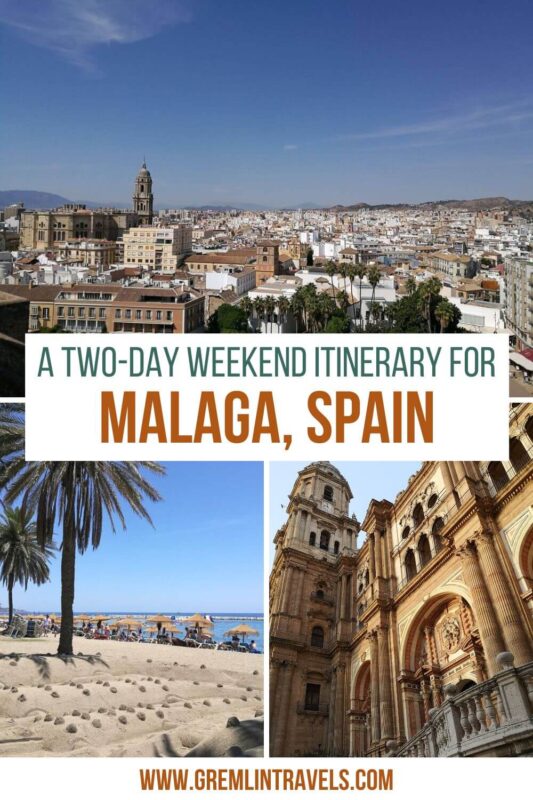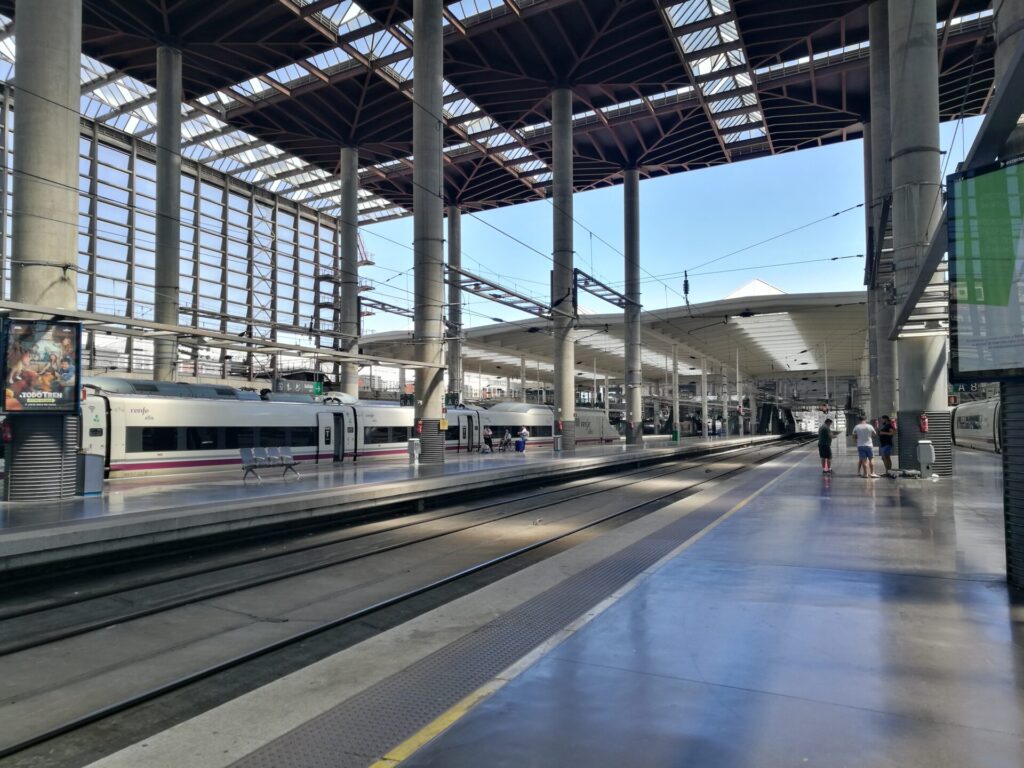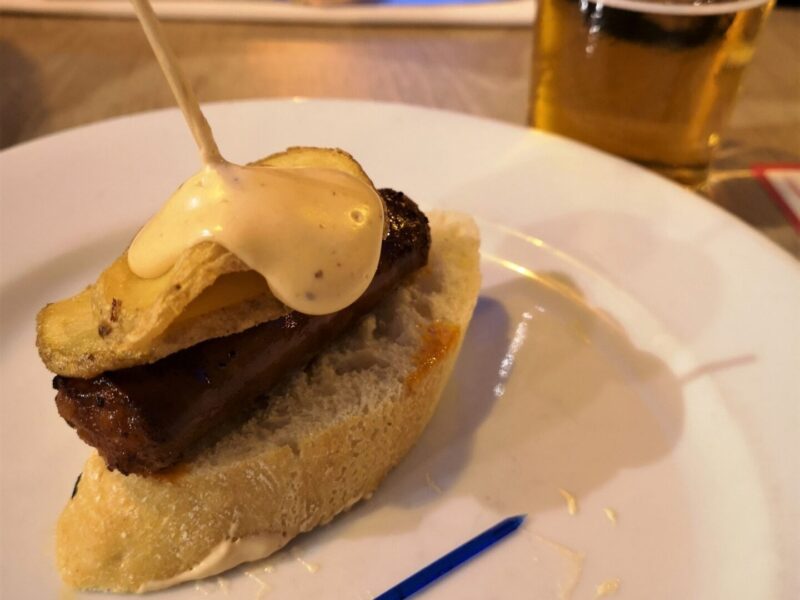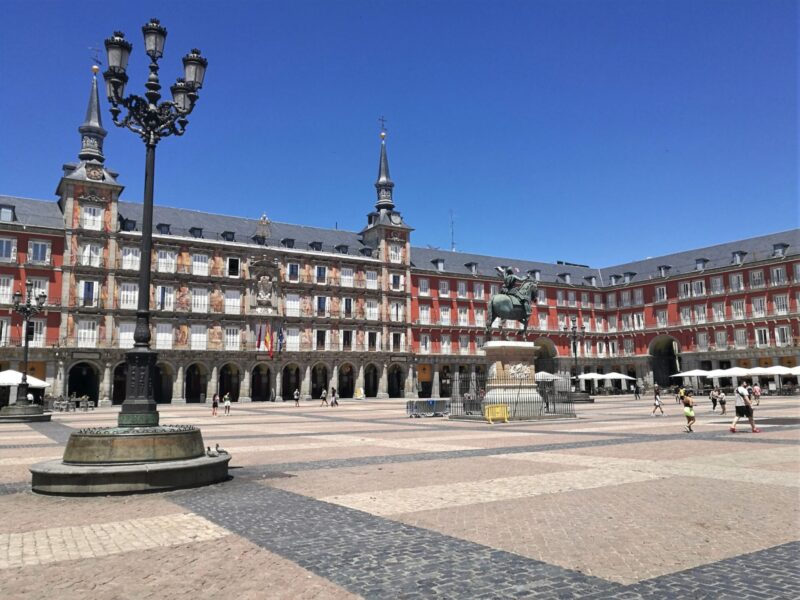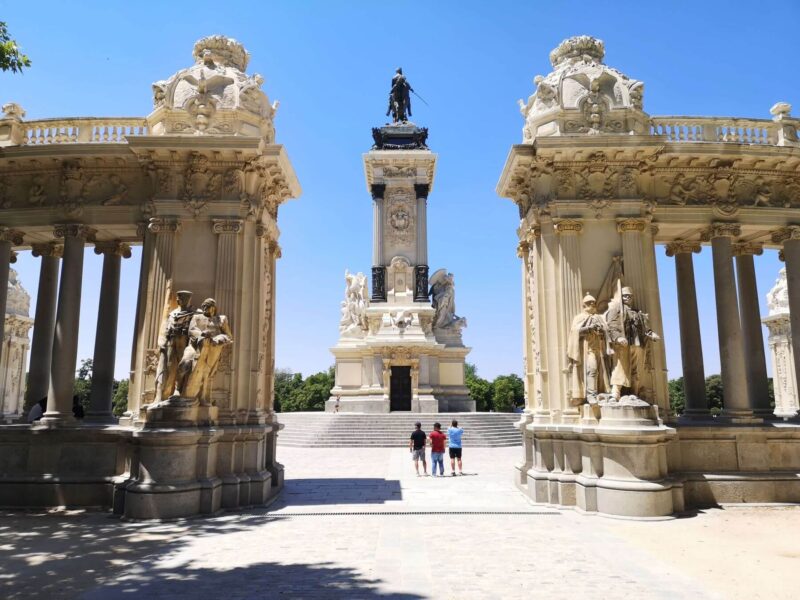Located in southern Spain, in the Costa del Sol region, Malaga city has increased in popularity as a tourist destination in recent years and investment in arts and culture has given it a firm place on the list of Spain’s best cities to visit. With a plethora of museums, a stunning old town and a 1200m long sandy beach, Malaga is the perfect destination for a sunny city break, a family holiday or a romantic weekend. We’ve put together a two-day itinerary for Malaga to get the best out of visiting the city. Alongside seeing some of the most major sites, we’ve included where to eat, where to stay and a small trip out of the city. So, if you’re looking for the best way to spend a weekend in Malaga then read on for our 2-day Malaga itinerary.
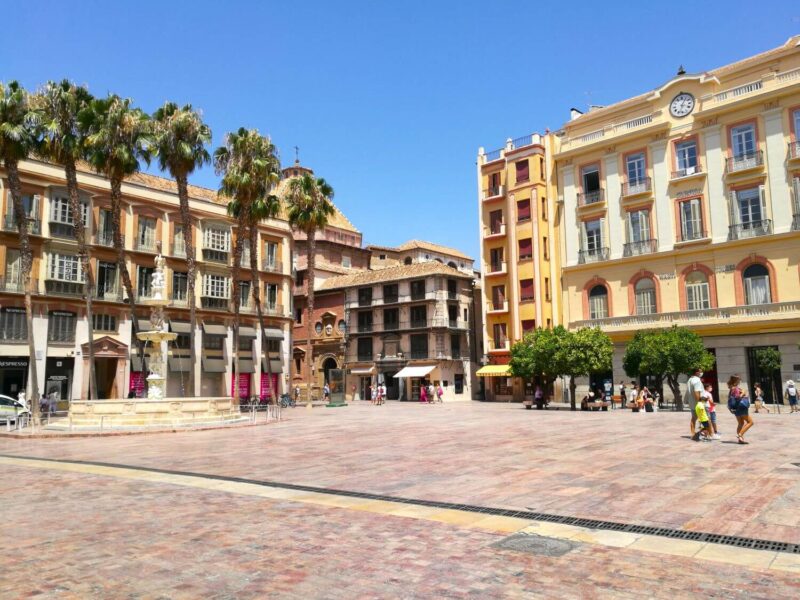
How To Get to Malaga From Malaga Airport
Malaga has a well-connected airport located just 8km from the city centre which, alongside the equally well-connected Maria-Zambrano train station, makes getting to Malaga a breeze whether you’re arriving from Europe or elsewhere in Spain. The easiest way to get from Malaga airport to the city centre is by taxi or bus, depending on how much you’re willing to spend. A taxi will cost in the region of €25-€30 ($30-$35) and will take around 15 minutes. The Linea Express A bus leaves from outside departures every 30 minutes and takes around 15-25 minutes to reach the city centre. Tickets cost €3 ($3.50) per person for the bus. If you arrive at Maria-Zambrano via Spain’s excellent high-speed train network then you can take either a taxi or bus to the city centre as well. You can read all of the transport options with prices and times in our extensive Malaga travel guide.
Top Tip: If you’re planning to explore Spain with trips to multiple cities via the high-speed rail lines you can book your tickets in advance and save money on Trainline. Prices, journey times and facilities for each train are all shown very clearly and you can even download the tickets to your phone.

Weekend In Malaga Itinerary; Day One
Atarazanas Market & Breakfast In Malaga City
Visit Atarazanas Market in the city centre to start your weekend in Malaga. The market is split into three areas which cover meat, seafood and fresh produce. It is at its busiest in the morning when locals stop by to grab ingredients and produce for the day, so it’s a great time to see the market in action.

After exploring the market, try a typical Spanish breakfast of churros and coffee at Casa Aranda. This is a typical Spanish churreria located just a minute or so from Malaga central market that has been open since 1932 and has become a bit of an institution in Malaga city. Alongside churros, they also serve a range of bocadillos, which are a type of Spanish sandwich.
Explore The Alcazaba Of Malaga
Full of energy from a Spanish breakfast, make your way to the entrance of the Alcazaba of Malaga. Before making the walk up the hill to discover the Alcazaba complex, stop by the Roman amphitheatre at the base, which is the oldest monument in Malaga city. It was originally built in the first century BC but, after many centuries of conflict and various leaders, was buried under rubble. It was discovered in 1951 but it wasn’t until 2011 that it became open to the public.

The Alcazaba takes around 1.5-2 hours to walk up to and explore and is best done before midday, to avoid the strong midday sun and heat. The complex sits on Mount Gibralfaro and was built in the 11th century. It is one of the best-preserved Alcazaba in Spain which is evident in the superb architecture, gardens and fountains within the complex. While much of the original palace is gone, the fortifications that remain today make up around half of the original structure. The Alcazaba is widely considered to be one of the best things to do in Malaga so be sure not to miss this!
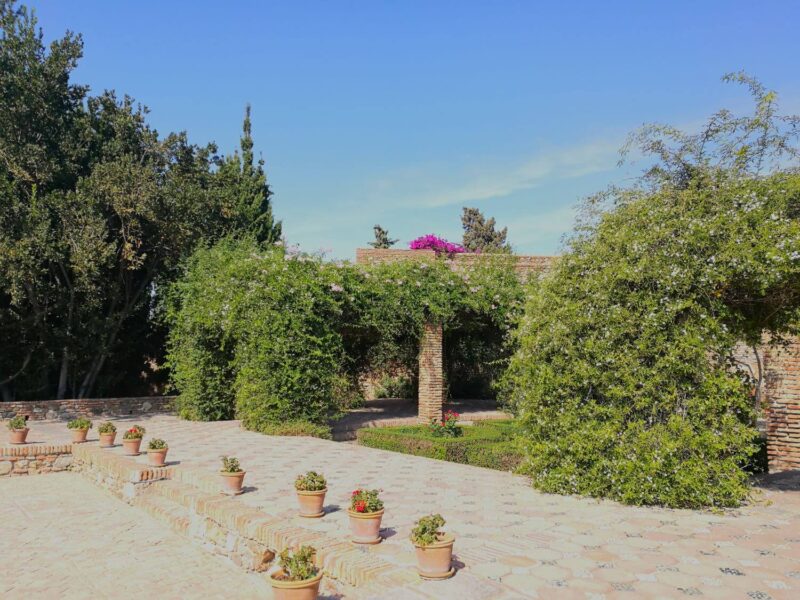
While on Mount Gibralfaro, we highly recommend also visiting Gibralfaro Castle. Combined tickets for both the Alcazaba and castle are available from €5.50 ($6) per person. The castle remains have one outer wall and one inner wall, which would have provided it with extra protection when it was originally built to defend Malaga in 1340. As you wander the castle you can see the main courtyard area, the weapons courtyard and ruins which make up a mosque and towers. Stunning views across Malaga and the sea are also one of the highlights of visiting the castle and Mount Gibralfaro.
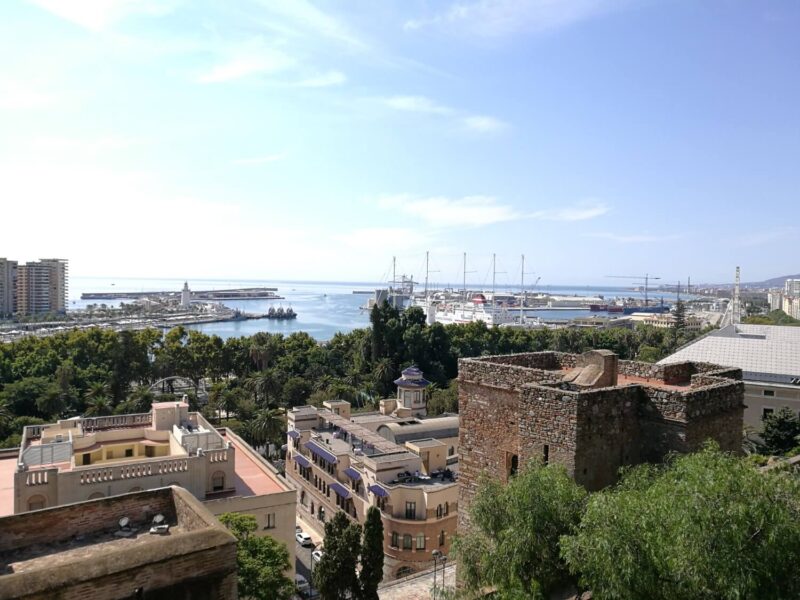
Take A Stroll To MalaGueta Beach For Lunch
From the Alcazaba entrance, it’s a 20-25 minute stroll to Malagueta beach. Walk through the Parque de Malaga on the way to the beach. The park opened in 1897 and is home to a variety of plants, trees and flowers that have been carefully landscaped around the paths. It’s a pleasant walk and an ideal way to get from the old town to the beach area.
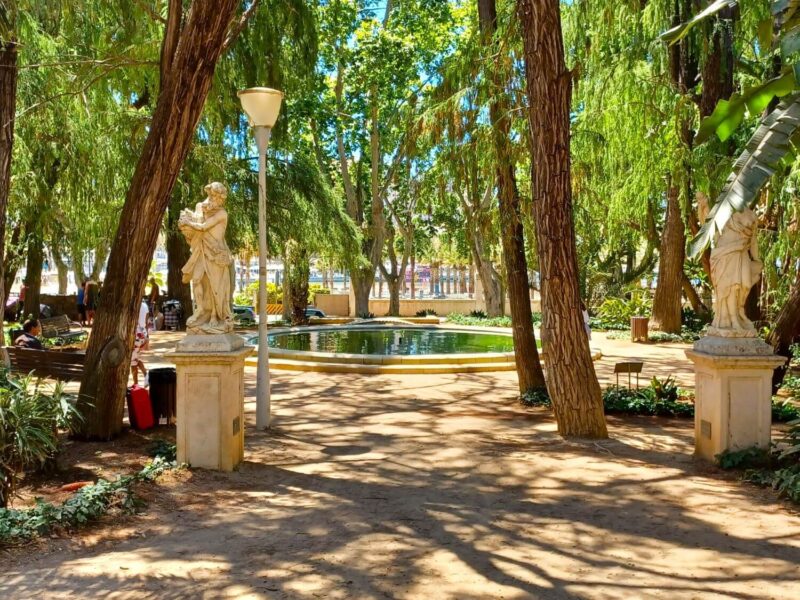
Before diving into the sea, enjoy a leisurely Spanish lunch at one of the many chiringuitos along the beach. These are beach-side restaurants that specialise in seafood, fish and Spanish foods. Outside many of these beach restaurants, there will be old boats filled with charcoal and wood with fresh fish and skewers of sardines roasting on them. At lunchtime, the restaurants will generally get busy around 2-3 pm, which is typical for lunchtime in Spain. We recommend eating at El Cachalote as it’s one of the best chiringuitos along the beach to offer up freshly caught grilled sardines, fish and seafood in a relaxed setting.
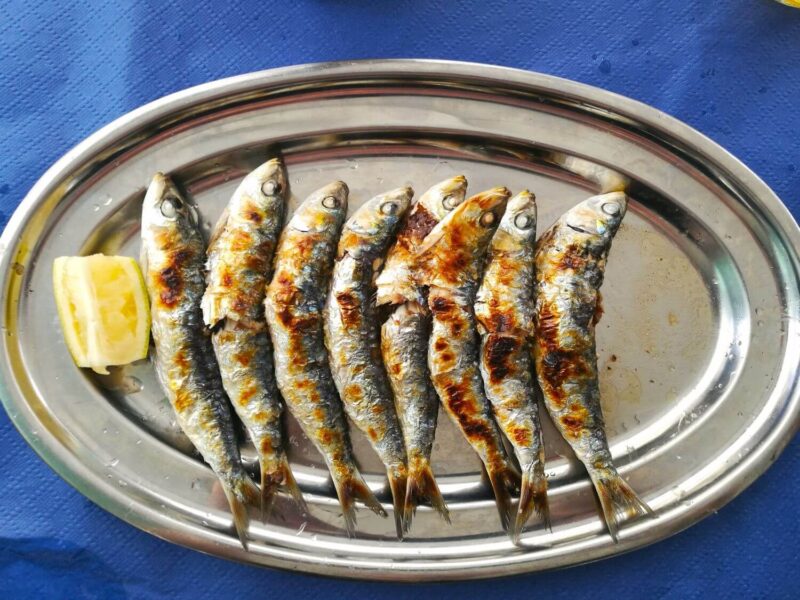
Relax On Malagueta Beach & Stop By The Port
After lunch, relax in the sun and take a dip in the ocean along the spacious and sandy Malagueta beach. The long beach combined with the beautiful city is what makes Malaga such a versatile and vibrant destination within Spain. The opportunity to enjoy city culture and beach relaxation within minutes of one another is rare and makes is just one of the many reasons we recommend a weekend in Malaga as a great mini-getaway.
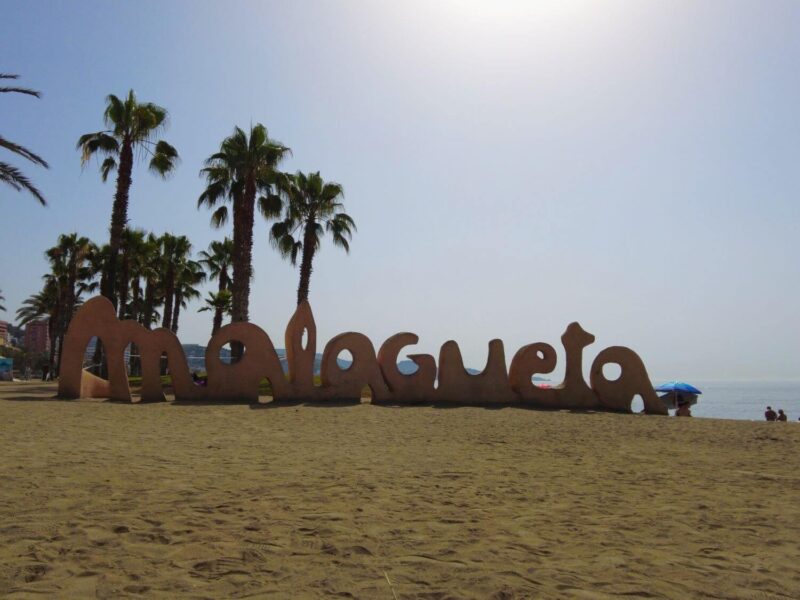
When walking back to the old town from Malagueta beach, stop by the renovated port and marina area. There are shops, bars and restaurants here which line the marina. Alongside a few high-end restaurants, there are also a number of the larger international restaurants in Malaga along here that are good for families visiting the city. Other sights around the port area include the lighthouse, the Pompidou Centre and a host of sightseeing boat trips that depart the marina regularly. It’s nice to stop for a drink in one of the many cafes and bars and enjoy the scenery of boats coming and going.

Evening Drinks & Tapas For Dinner
Not only is Malaga a great place to be during the day, with plenty to do and see, but it also has great nightlife and tons of amazing restaurants! If you want to dine with the locals, make sure to head out for dinner around 9 pm or later. Many restaurants open at 7 pm or 8 pm and it’s common in Spain to see the locals out for dinner at 10 pm or even 11 pm.
While there are lots of traditional Spanish tapas restaurants in Malaga, we recommend going to La Barra de Zapata for a mix of traditional, modern and creative food. The restaurant is a few minutes’ walk from Malaga Cathedral and has indoor and outdoor seating. The menu features traditional Spanish tapas dishes alongside dishes inspired by international cuisine and Spanish ingredients.

For drinks after dinner take a short stroll up the road, past the Cathedral, to Calle Granada, where you’ll find a host of bars that are busy well into the early hours of the morning. If you’re new to Spanish cuisine and drinks then try a Sangria which is a red wine-based drink with fruit added and commonly soda or brandy too.
Weekend In Malaga Itinerary; Day Two
Go Big For Breakfast At BrunchIt
Start the second day of your weekend in Malaga big with breakfast at Brunchit Espana. Located next to Malaga central market, Brunchit now has a few branches across Spain but its original store was in Malaga. They serve up fresh, delicious breakfasts including waffles, pancakes, omelettes and health bowls. The portions are quite big but it’s the perfect way to wake up and get ready for the day ahead.
Explore La Concepción Botanical Garden
After breakfast, escape the central part of Malaga and head to La Concepcion Botanical Gardens. To get to the gardens, either take the no.2 or no.91 bus or take a 10-minute taxi journey which will cost around €10 ($11). The Botanical Gardens are a great way to get out of the city for a while and immerse yourself in some natural surroundings. Originally built in 1855 by an upper-class family of Malaga, they were extended and added to in 1911 when another family bought them. Eventually, the gardens went into disrepair and were bought by the Malaga council in 1990 and opened to the public in 1994.

The gardens are split into several areas including a black bamboo forest, lily ponds, a wisteria arbour, palm gardens and a cactus garden. Trails and paths connect the various areas as well as a more challenging forest path on the high elevation behind the gardens. A beautifully tiled pergola, also known as the Mirador, is the symbol of the gardens and is the perfect place to enjoy a rest and view over the city. Exploring the gardens can take anywhere from 1.5 to 3 hours, depending on which routes you take. Entry into the gardens costs €5.20 ($5.75) per person.
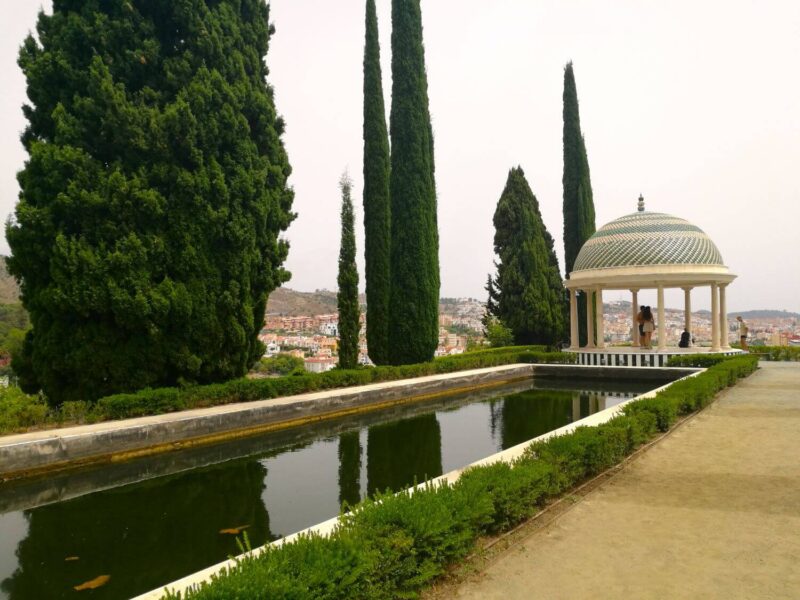
Spanish Tapas For Lunch At El Pimpi
For an Andalusian tapas experience head to El Pimpi for lunch. Located opposite the Roman amphitheatre in Malaga’s old town, El Pimpi has been open since 1971 and is one of the Malaga restaurants frequented by locals and tourists alike for reliably good tapas. The menu features a range of traditional Spanish and Andalusian dishes alongside seasonal specialities. While the restaurant has lots of outdoor seating, it’s also worth looking inside at the typical Andalusian tavern styling and the charming planted areas and courtyards. We recommend trying one of the many hams from the extensive Iberian ham section of the menu, which are all truly delicious!
Visit Catedral de la Encarnación de Málaga
Stuffed with delicious tapas and ready to take in some local history and culture, take a short walk to Malaga Cathedral. Known by a few different names including Nuestra Señora de la Encarnación and Our Lady of Incarnation, Malaga Cathedral and its tall tower can be seen across much of the city. An interesting fact about Malaga Cathedral is that it was never officially finished. It was planned to have two towers but when construction funds for the cathedral were reallocated to help the American independence from the British, the second tower was never built. Some locals have given the cathedral the nickname ‘The One-Armed Lady’ as a result.
can be seen across is a landmark of the city and Malaga region. Having begun construction in 1530, work on the Cathedral ended in the 17th century, although it was never finished. A second tower to the Cathedral was planned to be built but never was because funds at the time were reallocated to help the American independence from the British. This has made the Cathedral an important landmark due to its witness and existence throughout many key events in Spanish history. The architecture is a mix of Baroque and Renaissance styles and is a fantastic example of some of the best Spanish religious architecture. The interior is also delightful and has several great artworks. You can go inside the Cathedral as well as up into the tower, both of which we highly recommend as one of the best things to do in Malaga when visiting.
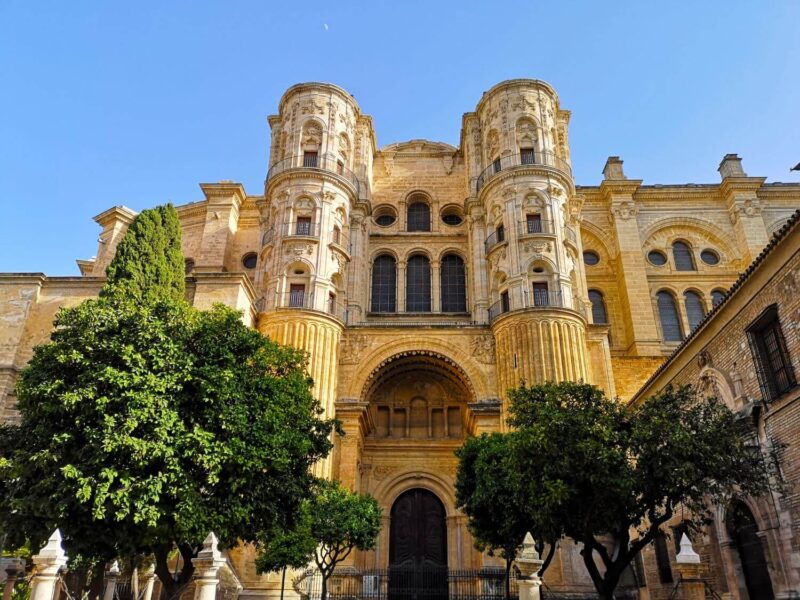
Construction on the cathedral started in 1530 and ended in the 18th century. Its architecture is a mix of Baroque and Renaissance styles and it is a fine example of Spanish religious architecture. The interior is equally as impressive and contains many great artworks alongside noteworthy sculptural pieces and choir stalls. Visitors can buy tickets to visit inside the cathedral and to go to the roof of the cathedral. Tickets for either the cathedral interior or roof only are €6 ($6.50) per person or combined tickets for both are €10 ($11) per person. We recommend doing both the inside and roof if you have time but, if you only have time for one, then visiting the inside of the cathedral is advisable as it’s one of the best things to do in Malaga.
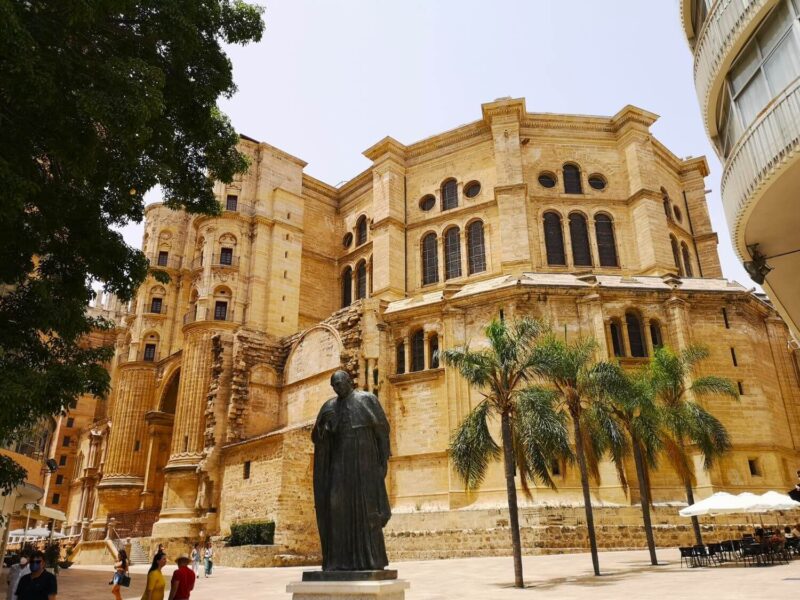
Learn About Picasso At The Picasso Museum
Next up is a visit to the Picasso Museum, located rather discreetly within Malaga Old Town. Pablo Picasso, arguably one of the most influential and well-known artists in the world, was born in Malaga and the museum opened in 2003 as a celebration of his life and work. There are over 200 of Picasso’s works in the museum that were given by the private family collection. The works highlight the various styles, materials and techniques that he worked with and showcase the talent, skill and mind of the exceptional artist. Tickets to the permanent exhibition cost €9 (£9.50) per person.
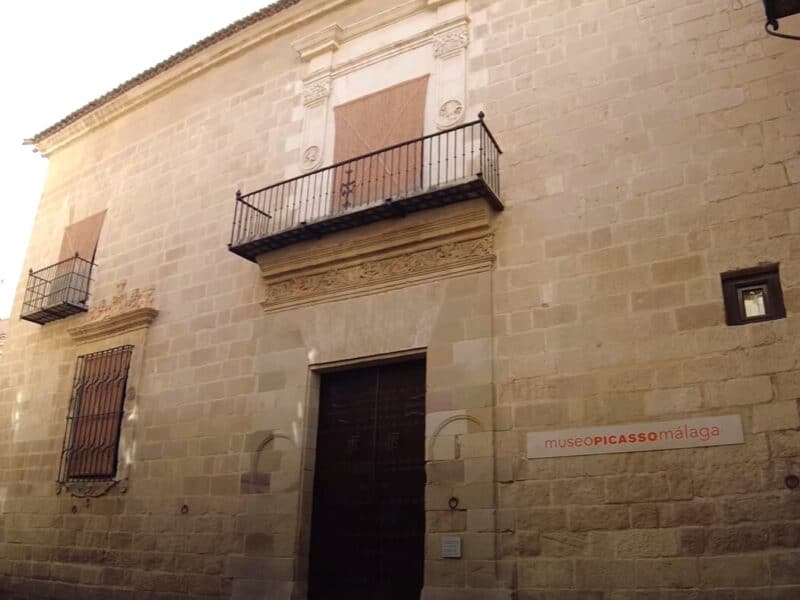
Explore Malaga Old Town
Lastly, to finish a day of sightseeing in Malaga, take some time to explore its extensive old town. Throughout the maze of small streets and large vibrant squares that make up the old town are boutique and independent shops, bars and restaurants which contribute to the local atmosphere that makes the old town so special. Malaga’s history and important seaside location have led it to experience a diverse past and the old town is a great example of the many architectural styles that have merged to form the varied townscape that exists in Malaga today. Although the cathedral can be spotted through most of the small alleys of the old town, keep an eye out for some of the other ornate churches that are spread throughout the backstreets of the old town.
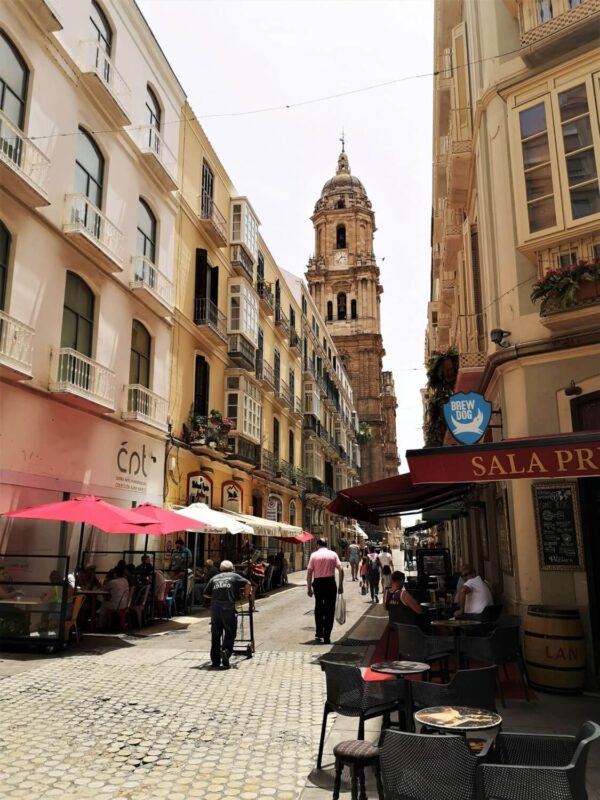
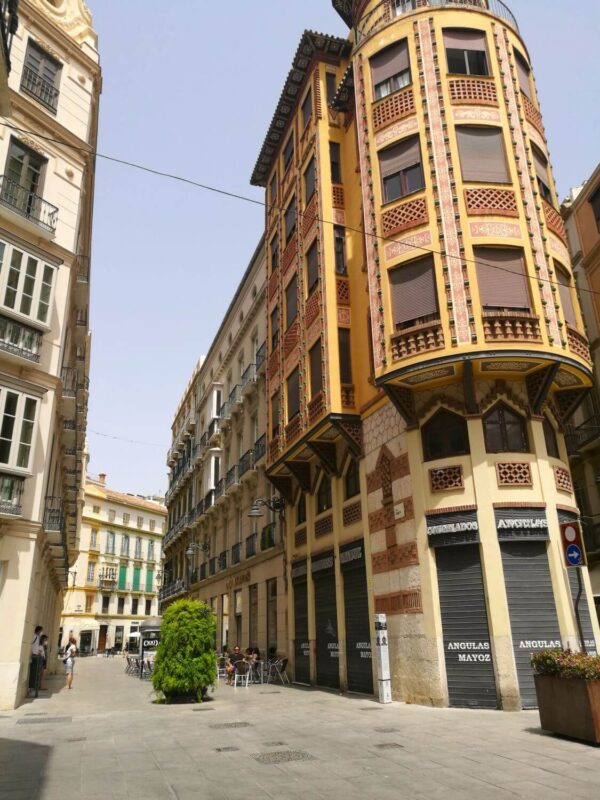
Some of the most notable streets and squares to see within Malaga Old town are the Plaza de la Constitucion, a large square with a fountain and shops and restaurants, and Chinitas Passage, which is a famous arched passageway. For shopping, take a stroll down Calle Larios, Malaga’s grand shopping street.
A Hearty Spanish Meal In Malaga Old Town
End your weekend in Malaga with some of the best simple Spanish food in Malaga. Lo Gueno has two restaurants in Malaga centre with its oldest having been operating since 1967. While the menu is extensive and includes tapas, they specialise in slow-cooked Spanish meats and paella. Portions are large so make sure you come with an appetite! This is where to go for friendly service and a hearty Spanish meal.
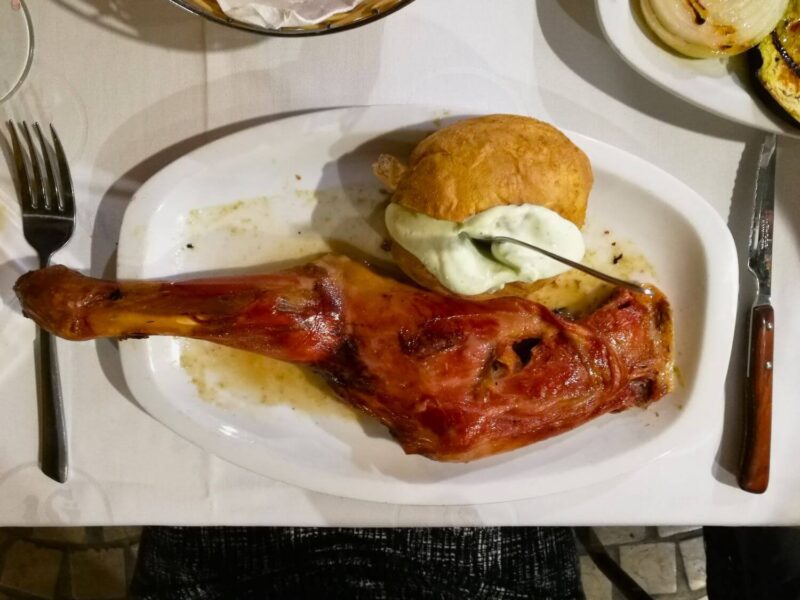
With your two days in Malaga over and your weekend in Malaga done, we hope you have enjoyed our best of Malaga itinerary which is an introduction to Malaga city. We’ve got lots more information about visiting Malaga in our Malaga travel guide including how to get to Malaga, when to go and what to eat. If you’re planning to explore more of Spain then check out our Spain travel guides which include guides for Seville, Madrid and Barcelona.
Where To Stay For A Weekend In Malaga
Budget/Hostel – The Urban Jungle Hostel
The Urban Jungle Hostel is a great option for those wanting accommodation in the heart of Malaga’s historical quarter that is both inexpensive but still stylish and cool. The laid-back vibe at the hostel is perfect for relaxing after a busy day of exploring. Room options include dormitories as well as private rooms and family rooms, all of which are light, airy and modern. There is also a shared kitchen and terrace for guests to enjoy.
Mid-range Hotel – Hotel Boutique Teatro Romano
Situated in the heart of Malaga’s historical quarter, Hotel Boutique Teatro Romano offers visitors to Malaga a spacious, contemporary and well-equipped hotel with reliable service. It’s the perfect base for exploring the city and a simple breakfast offering means you’ll be prepared for sightseeing every morning.
High End Hotel – Hotel Molina Lario
Widely considered as being one of the best hotels in Malaga city, the 4-star Hotel Molina Lario is a family-run hotel in the centre of Malaga that has recently been refurbished. Beautifully decorated rooms alongside a rooftop bar and pool give guests everything need to relax and unwind after a day of exploring Malaga city.
Pin this article to save it for later or share it with others
